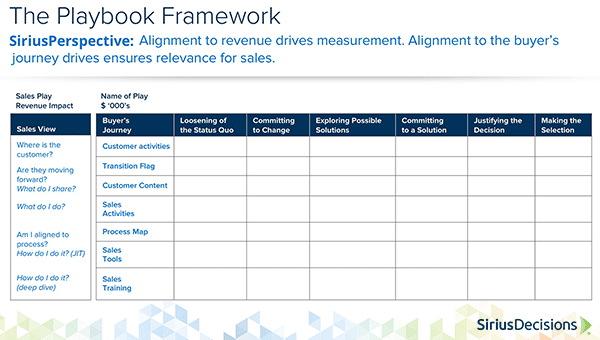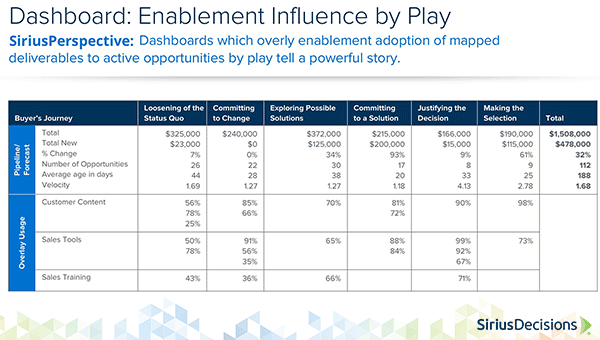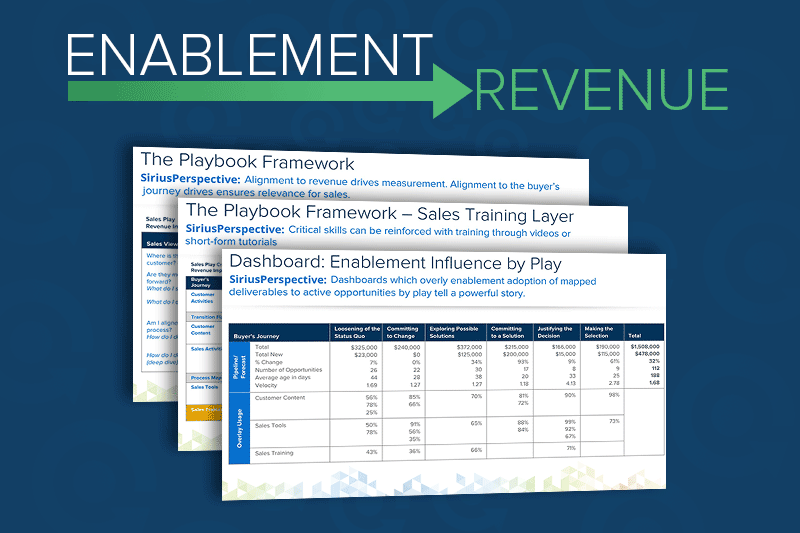Recently, we co-hosted a webinar with SiriusDecisions called Connect Sales Content to Revenue. This session was chock-full of research-backed advice to help you turn your sales enablement efforts into measurable revenue contributions. If you want to take sales enablement to the next level, there are a few important steps to consider, and we’ve outlined them below from the webinar discussion.
It’s important to note that before you get started, you’ll want to meet with sales finance to obtain your organization’s revenue plan. Measuring sales enablement’s impact on increasing revenue is the key to ensuring your efforts drive the greatest impact on business value, and you need the revenue plan to do it. This step often gets missed, and that’s a shame because sales enablement loses out on its “seat at the table” as a result. Don’t lose your seat at the table! Start with sales finance and then use the four steps below to start turning your enablement efforts into revenue.
Four Steps to Turn Sales Enablement into Revenue
- Map the Revenue Plan into “Sales Plays”
Once you have the revenue plan from sales finance, it’s your job to convert that plan into specific “Sales Plays” or go-to-market plan. A Sales Play is a specific, executable selling motion mapped to the buyer’s journey. Even within large companies, you’re best off to focus on a very reasonable number of Sales Plays that take the lion’s share of the revenue for the year (three to six buckets at the most). - Map the Buyer’s Journey to Sales Plays and Create Playbooks that Ensure Success
Sales reps need playbooks based on best practices to be able to consistently and optimally execute the Sales Play. But we’re not talking about your run-of-the-mill sales playbooks. Effective playbooks are a guide based on the buyer’s journey that maps all of the available sales content, tools, training and best practices available to help sales reps execute and close deals. For example, this framework from SiriusDecisions captures the information that should be included in a modern sales playbook:
When complete, it has available content (both customer-facing and sales tools, and training) for each stage of the buyer’s journey. Sales can quickly determine what content to use depending on the buyer’s stage—there’s no room for confusion.You may find that you have a lot of content for the first two stages of the buyer’s journey and not a lot for the rest of the journey—this is common. Oftentimes, when building a playbook, companies have to pause and build out the rest of the content that they need to support all of the stages in the buyer’s journey. So, in some ways, the playbook forces marketing to be more complete as well—it gets all of the requirements on paper upfront so there are no last-minute content panics.
Important note: Rolling out a playbook is not a “set it and forget it” action. You need to make sure someone is accountable to update and maintain the playbook when things change—which they always do—so that sales always has the most current, up-to-date content information. To make playbooks more digestible, break them up by stages of the buyer’s journey and map them directly to the Sales Play and buyer’s stage, directly in your sales enablement and CRM system.
- Map Playbook Results to Revenue Streams
With your playbooks complete and in the hands of sales, you’re now armed with the ability to prove how content within the playbook helped closed deals. To do this, you need to create a dashboard that tracks the key business metrics and sales enablement metrics together, and a platform that enables you to measure the impact from Sales Enablement efforts. This example from SiriusDecisions is particularly good, and we talked through it in the recent webinar.
- Implement Sales Enablement Technology
Your metrics are only as good as the technology used to track and measure them. A good, modern sales enablement platform like Highspot will provide content usage, customer engagement and revenue influence analytics, and possibly other business metrics such as velocity uplift and deal size uplift. You want a platform that provides in-depth analytics needed to show content usage by sales, and importantly, content usage by clients and prospects. With this information, you can provide direct correlations to sales enablement and revenue numbers. You can know for sure which content directly impacted a sale and which content is ineffective.Better yet, sales enablement platforms provide content effectiveness results in real time, which means you can optimize and deliver what helps sales close deals almost instantly instead of waiting entire six-to-nine month sales cycles to know what works and what doesn’t.
Better yet, sales enablement platforms provide content effectiveness results in real time, which means you can optimize and deliver what helps sales close deals almost instantly instead of waiting entire six-to-nine month sales cycles to know what works and what doesn’t.
If you’re interested in learning more about turning content into revenue, I highly recommend watching the on-demand version of the webinar because we covered this content in much more detail. And, if you need help along the way, we’re here. As part of onboarding, we help Highspot clients conduct a content audit, which is a critical piece of the content to revenue connection. You can download our content audit worksheet here.




![[Research Round-Up] New Study Shows the Continuing Value of B2B Thought Leadership](https://customerthink.com/wp-content/uploads/development-2010010_1280-pixabay-innovation-ideas-think-1-218x150.jpg)